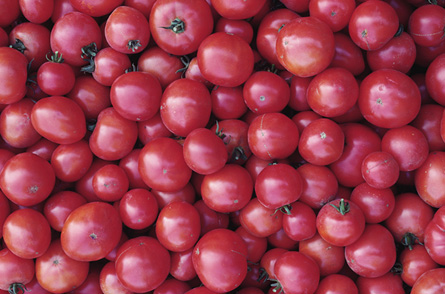Wash Your Veggies!
Over the past week, a fear of tomatoes has stricken the nation’s salad lovers. It was triggered by a salmonella outbreak that’s stricken more than 165 consumers of Roma, Italian-style plum, and round red tomatoes. The poisonings occurred in 17 states, mostly out West.

Not all tomatoes seem to pose a risk. “Cherry tomatoes, grape tomatoes, and tomatoes sold with the vine still attached from any source” appear safe, according to the Centers for Disease Control and Prevention. These exempt categories are the ones my family tends to buy. But even so, I still wash every tomato that I serve. And a question arises, had the tomatoes that sickened people in the current outbreak been cleansed really well?
In our great-grandma’s day – and probably our mom’s as well – salad greens and other fruits and veggies weren’t handed out for family consumption until they were first scrubbed clean in the kitchen sink. Many of today’s homeowners seem to think that’s too much work. So they buy bags of cut lettuce and other greens that come to the grocery store prewashed. Labels on some bagged lettuce actually say that washing is superfluous.
Yet it’s hard to guarantee germfree produce, as food-poisoning outbreaks have illustrated over the past few years. That hasn’t stopped salad-packaging companies and distributors from attempting to get germfree crops. Last year, for instance, the salad industry began imposing fairly draconian measures on most of the nation’s lettuce and spinach growers. Anything but voluntary, their so-called leafy greens rules make farmers jump through numerous costly and time-consuming hoops with the goal of barring potential germ carriers from a grower’s fields.
And by germ carriers, they don’t mean runny-nosed toddlers. They’re talking birds, frogs, slugs, deer, and pigs. Of course flies have been linked to E. coli and Salmonella too.
Can we reasonably expect farmers to keep nature out of their fields? Do we even want them to? Part of developing a healthy farm environment involves nurturing natural ecosystems. And animals, from slugs and birds to insects, anchor ecosystems.
I’d argue that the mistake is to try and sanitize — much less ultra-sanitize — farms. Keep in mind, we’re talking about environments based on dirt. Ones that are aerated and partially fertilized by worms. Although feces of birds and bugs may harbor germs, the tradeoff is that those same birds and bugs can help nab pests without reliance on toxic pesticides.
To date, the leafy-greens rules have focused on farmers that grow — well — leafy greens. But there has been talk about extending these rules or one similar to purveyors of other types of produce. Such as tomatoes, or apples, or berries or carrots.
Although it is reasonable to expect that farms attempt to minimize bacterial contamination, I think it’s not reasonable to expect that foods grown outdoors will be antiseptic. So I’d argue that it’s also unreasonable to expect that we can safely forego washing produce (or sanitizing them with a spray of vinegar and hydrogen peroxide).
The lesson in all of these food-poisoning outbreaks is that we must not expect a risk-free food-supply chain. Instead, we should embrace the precautionary principle and assume that they’re all tainted (as we do now with eggs and raw ground beef) and do our best to scrub them clean.
Be just as careful, of course, in washing your hands after touching raw fruits and veggies.







